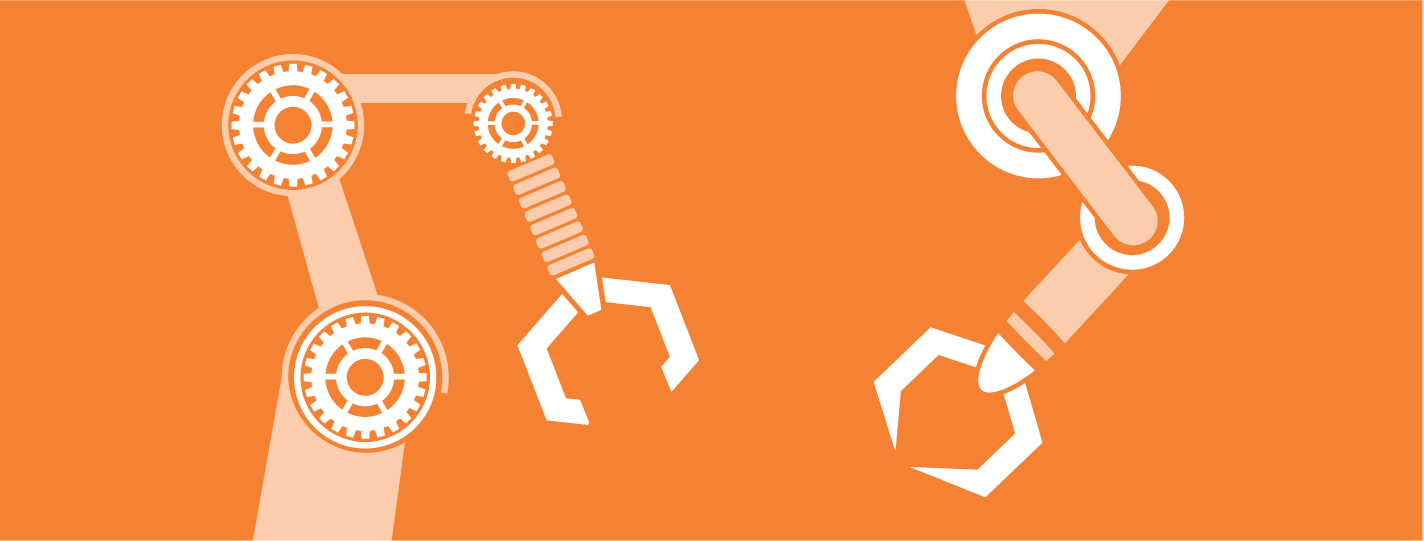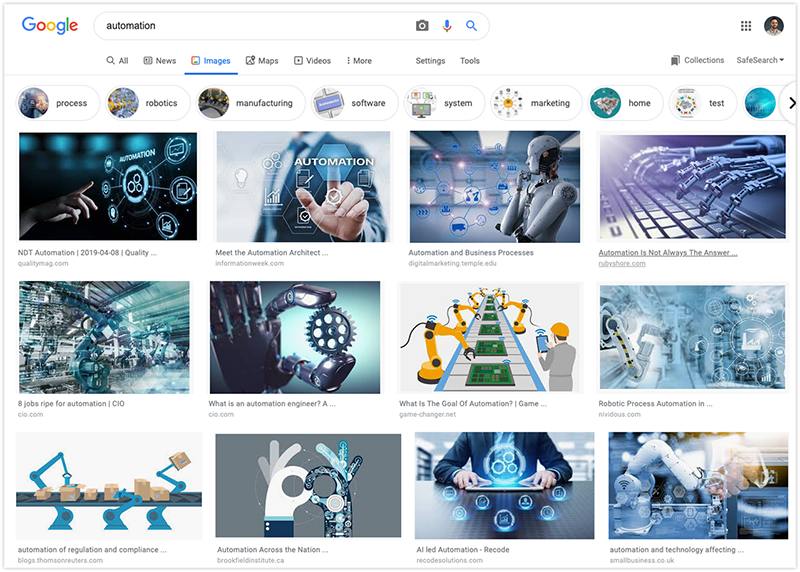
Robotic Arms (for your Sales and Marketing Operations)
Go ahead and do a Google image search for the word “automation.”
95% of the images you’ll find are from the manufacturing world:
Complex, computer-run facilities with robotic arms moving boxes onto conveyor belts and IOT-enabled machinery assembling equipment.

So you’d think if anyone understood how to apply automation to sales and marketing, it would be the industrial sector, right?
Well, not so much.
Instead, the same manufacturing experts who have mastered the complex practices of automating assembly lines with robots, designing smart factories and 3D printing components from digital files are the same people spending $5K/month on print ads to drum up awareness and manually tracking leads in spreadsheets.
I can’t be the only one thinking that something doesn’t feel right about this picture!
But here’s the good news:
When compared to the complexities of manufacturing automation, sales and marketing automation look like child’s play.
In this article, we’ll take a peek at seven ways manufacturers can apply the very familiar concept of automation to their methodologies for filling the sales pipeline and closing new customers.
Automation in Prospecting: Outreach Email Sequences
A simple Google search for “email outreach software” will turn up an abundance of tools for email prospecting. Some our favorites, to name a few, include Woodpecker, Prospect.io and LeadFuze. And typically, a core feature you’ll find in these tools is the automated email sequence.
Automated sequences are essentially series of prewritten prospecting emails you’ll draft and then deploy with a predetermined cadence to initiate contact with an entire list of individuals at once. If your first email doesn’t generate a reply, the second will automatically send after three or five days, and so on.
The downsides to automated email sequences are their limitations in regard to personalization, and of course the risk of being perceived as a spammer. That said, both of these negatives can be minimized with a smart segmentation strategy and on-point messaging. The upside is the efficiency of one-to-many communication.
Automation in Advertising: B2B Facebook Campaigns
I know. You might see Facebook here and think, “this is B2B marketing, not consumer advertising”. But given Facebook’s wealth of data and massive user base, it absolutely warrants a look in your B2B marketing mix.
The intriguing application of automation within Facebook’s advertising platform is the ability to sync with a list in your CRM or marketing automation software and serve up ads to those exact individuals.
For example, if you use Hubspot or Salesforce to manage leads, you can tell Facebook to show ads to your “SQLs” or “Active Opportunities” lists in those databases. And as your lists grow and evolve, your Facebook ads will keep pace.
Automation in Website Lead Generation: Chat Bots
We’ve all seen and used live chat software. But live chats are quickly evolving and in many instances, being replaced by chat bots. A leading software company in this space, Drift, recently coined the term “conversational marketing”.
Here’s how they describe it:
“Unlike traditional marketing, conversational marketing uses targeted, real-time messaging and intelligent chatbots instead of lead capture forms — that way leads never have to wait for follow-ups, and can engage with your business when it’s convenient for them (like when they’re live on your website).”
A well-programmed chat bot can guide visitors through your website by helping answer simple questions and direct them toward the most relevant information.
When effectively implemented, not only will a chat bot create a more seamless user experience, but it will help you generate more sales conversations with leads that have prequalified themselves.
Automation in Lead Qualification: Behavioral Lead Scoring
Speaking of lead qualification, one of the most common complaints I hear from B2B Sales professionals is that it’s too hard to sift through the unqualified inbound leads to uncover the good ones.
Behavioral lead scoring lets you score leads not only based on the information they provide through form submissions (like job title, geography, company size, etc), but also but also based on whether their actions on your website indicate buying intent.
Isn’t it fair to say that a website visitor who spends ten minutes looking through a handful of your product pages, reads three case studies and examines your Leadership Team page warrants more attention that a visitor who landed on your home page and left ten seconds later?
Automation in Lead Intelligence: Real-Time Notifications
You can configure marketing automation software like Hubspot to alert you in real time (by email or pop-up banners on your phone) when leads take specific actions on your website like:
- Opening one of your emails
- Clicking a link in those emails
- Revisiting your website
- Viewing a specific page (or set of pages) on your site
- Crossing a predetermined lead score threshold that indicates strong buying intent
Timing can be everything, and this kind of real-time intelligence helps you understand when specific leads are most engaged.
Automation in Lead Development: Triggered Email Workflows
When a lead is both sales-qualified and sales-ready, it’s time to be on the phone with them.
But if you have any experience with inbound lead generation, you already know that many of your leads might be qualified (just not yet ready for a sales conversation).
Email workflows are prewritten, automated series of emails triggered by specific actions taken by your leads.
Note that what I’m referring to here is different than the outreach sequences covered earlier in this article. While those focus on prospecting among large groups (and generating immediate sales calls), the email workflows I’m talking about are here are designed to gently nurture and develop earlier-stage leads in the background.
Here are a few applications for triggered email workflows:
- When a visitor subscribes to your newsletter, a prewritten “welcome” email hits their inbox the next day. Then two more automated follow ups in the coming days deliver your best, most-helpful content in a non-salesy manner.
- When a visitor downloads your Product Catalog, a series of three automated emails (one per week) deliver a related a Buyer’s Guide, a case study and a white paper. Then a fourth email suggests a phone consultation.
- When a previously active lead hasn’t returned to your site in a month, a reengagement campaign is triggered, delivering four helpful pieces of content over the next four weeks.
The possibilities with email automation are endless, with plenty of room for creativity.
Automation in Sales Communications: Starter Templates
How often do you find yourself composing a follow-up email or responding to a prospect’s question, while thinking to yourself, “I just answered that same question for someone else last week”.
These scenarios scream automation (or at the very least, partial automation).
Tools like Hubspot let you compose and store not only full email starter templates, but also predrafted “Snippets” that you can drop into an original email.
A few examples of helpful Templates and Snippets you might prewrite include:
- Answers to your most commonly asked questions
- Follow ups to preliminary conversations that link to helpful articles, pages or case studies
- “Yes” replies to consultation requests
- “No” replies to consultation requests
- Language to further qualify a lead before committing to a conversation
- An overview of your company’s experience and credentials
Every time you write an email to a prospect or lead, ask yourself, “Will I likely write this same thing again for someone else?”. If the answer is yes, then save the content as a template.
There’s no replacement for personal interactions
Before wrapping up, I’d like to be clear that I’m not suggesting automation as a replacement for real, face-to-face communication. Not at all.
Instead, I’m recommending automation as a means to optimize the time of your human talent.
Automation exists to arm sales and marketing professionals with intelligence and tools that increases their efficiency and effectiveness, while minimizing the grunt work.
When your time is better spent, your customer acquisition ROI grows. And no one’s gonna argue with that.